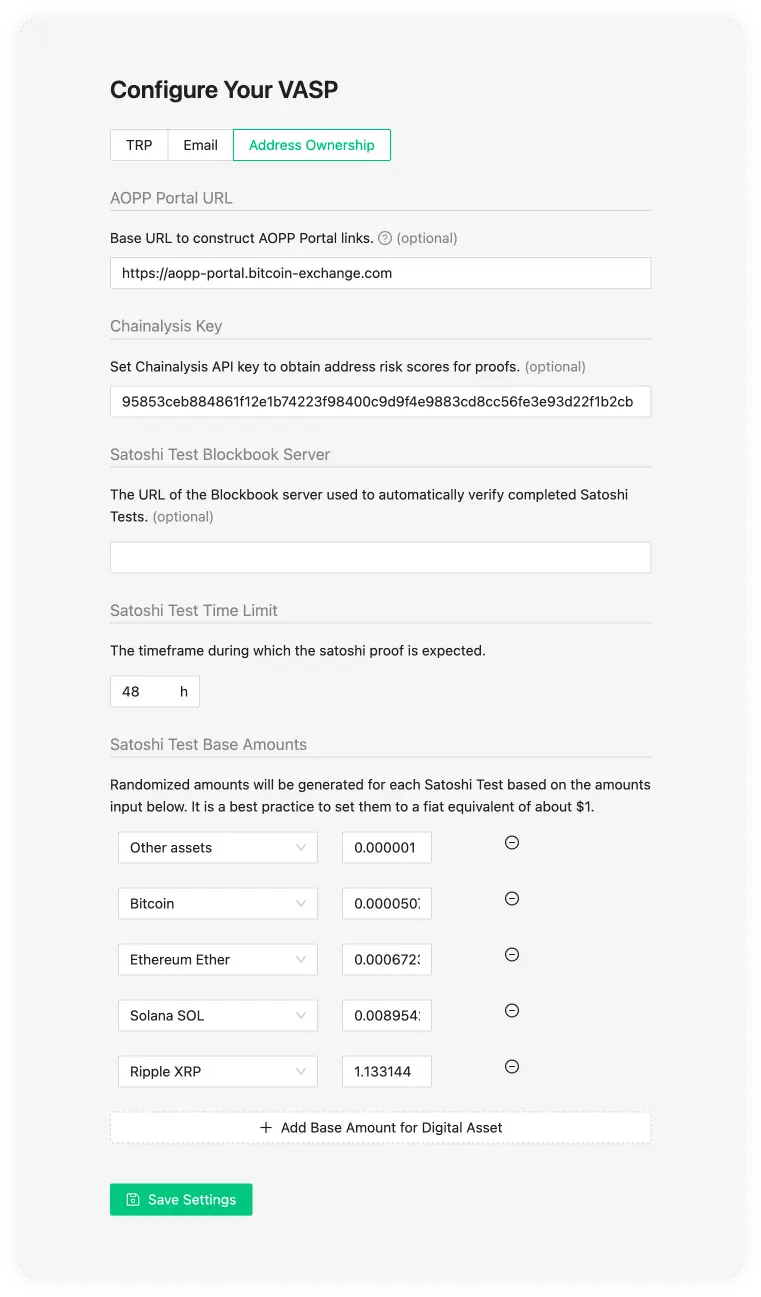Address Ownership
On the tab 'Address Ownership', you can configure the AOPP callback URL and Satoshi Test base amounts.

AOPP Callback URL (optional)
The end user's wallet uses this URL to submit an address ownership proof to 21
Travel Rule for verification. The callback URL will be auto-detected when left
empty (recommended). If auto-detection fails then usually there are
configuration mistakes in the
Caddyfile.
The option to bypass auto-detection is mainly provided for users that don't use
caddy.
NOTE: The callback URL is not meant to be used by API integrators to
obtain a submitted proof. Instead, use the
aoppAoppProofs GraphQL
subscription for that purpose.
AOPP Portal URL (optional)
The AOPP Portal service is part of the
Reference Deployment, and allows end users to
submit a signature ownership proof at a publicly accessible URL. If you
configure the base AOPP Portal URL here, you can direct a user to this URL after
requesting a signature proof. The callback URL will be auto-detected when left
empty (recommended). If auto-detection fails then usually there are
configuration mistakes in the
Caddyfile.
The option to bypass auto-detection is mainly provided for users that don't use
caddy.
Chainalysis Key (optional)
When a Chainalysis API Key is added then all the cryptocurrency addresses from the proofs are submitted to Chainalysis for risk analysis. The risk results are shown in the Proofs Overview Table. You can contact your technical team to request the Chainalysis API Key. The risk scores can be found in the Self-hosted Wallet Proof Overview page.
Satoshi Test Blockbook Server (optional)
When the Blockbook Server URL is added, submitted Satoshi Tests transactions will be automatically recognised by the 21 Travel Rule, which will monitor the blockchain for incoming transactions. This is done using a Blockbook server. Blockbook is an open-source blockchain indexing software (for more information see here) which can be run by anyone - the VASP who runs 21 Travel Rule, a 3rd party or 21 Analytics (get in touch with us for more information). If no URL is added then this feature will be disabled and the compliance officer will have to manually verify the Satoshi Test transaction using a block explorer application of their preference.
Satoshi Test Time Limit
You can select how much time the user has to conduct the transaction (Satoshi Test). After this time a check will be done to see if the values match.
Satoshi Test Base Amounts
Randomised amounts will be generated for each Satoshi Test based on the amounts input below. It is a best practice to set them to a fiat equivalent of about $1. It is possible to define base amounts for specific digital assets, all other assets will use default base value specified with "Other assets".
Use "Add Base Amount for Digital Asset" button to add new base amount entry.
NOTE: Default value of 1.0 coins is not always suitable for Satoshi test as it may be too large/small amount. So it is better to have sensible setup for all used digital assets.